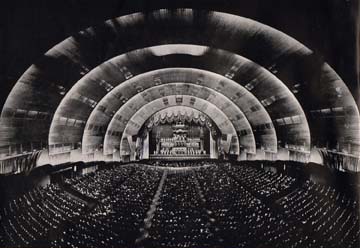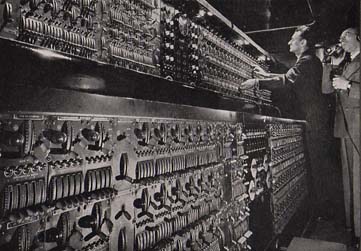

Built as part of the complex of buildings at Rockefeller Center, Radio City Music Hall opened on the 27th of December 1932.
Its 5,960 seats are only a small part of the phenomenal scale of the theatre.
Three massive pistons fifty-seven feet deep and twenty feet in diameter operated three separate stage elevators. In addition, there was a three piece revolving turntable fifty feet wide which also had the capability of to rise above or sink below the stage.
Together, the mechanical systems were able to take on a variety of configurations to create a three-dimensional workspace. In sequence, the stage could look like a wedding cake, an amphitheater, or a natural landscape.
Thirteen different motors controlled the cables sewn into the three-ton, satin faced, asbestos-lined stage curtain, the motors programmable to open up the entire 144-foot-wide proscenium or to close down like a camera shutter to a single man-sized opening.
An eight-thousand-gallon water tank lodged beneath the stage provided the hydraulics for the elevators, and a separate mechanism governed the bandwagon that rolled along the railroad tacks just outside the musician's dressing room to the top of the orchestra pit elevator, where it would rise to stage level. After completing the overture, the orchestra could then sink back down, and travel all the way beneath the stage to the rear elevator, which would lift the musicians back into audience view, this time behind the dancers or other performers.
